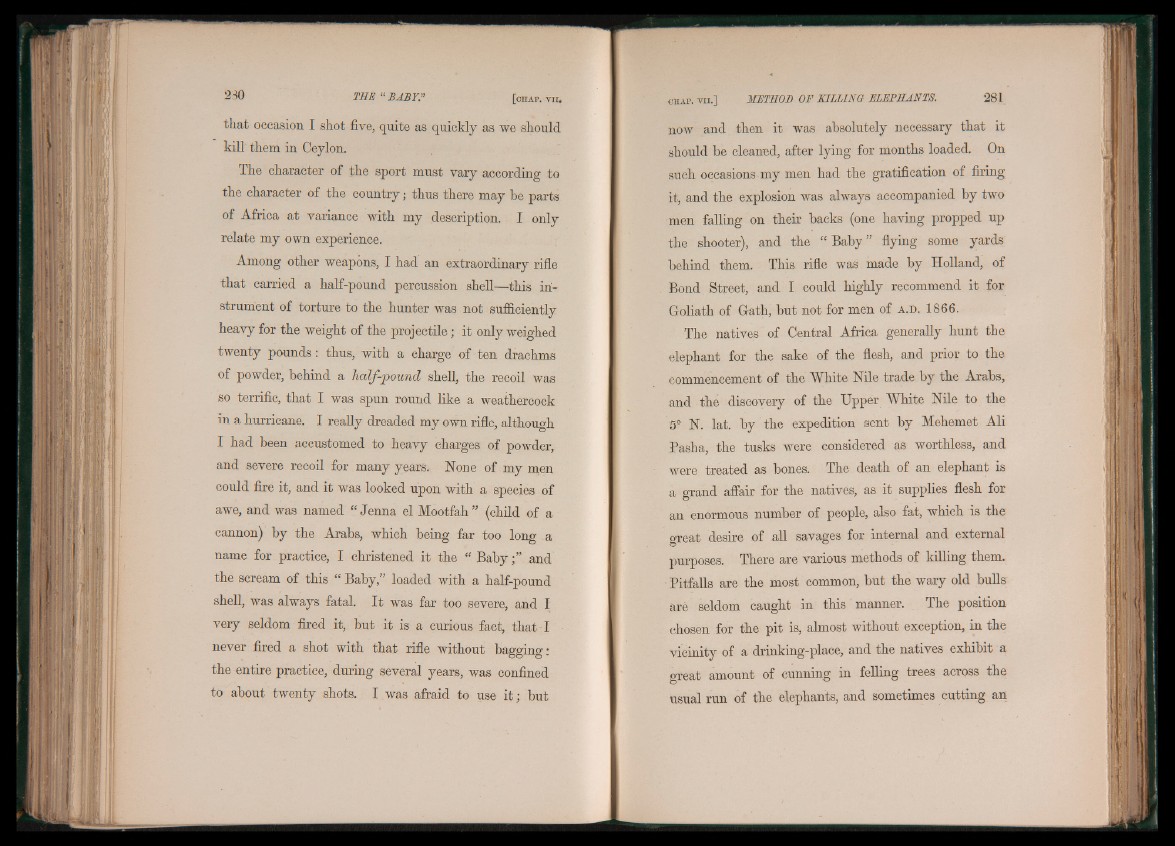
that occasion I shot five, quite as quickly as we should
kill them in Ceylon.
The character of the sport must vary according to
the character of the country; thus there may be parts
of Africa at variance with my description. I only
relate my own experience.
Among other weapons, I had an extraordinary rifle
that carried a half-pound percussion shell—this instrument
of torture to the hunter was not sufficiently
heavy for the weight of the projectile; it only weighed
twenty pounds: thus, with a charge of ten drachms
of powder, behind a half-pound shell, the recoil was
so terrific, that I was spun round like a weathercock
in a hurricane. I really dreaded my own rifle, although
I had been accustomed to heavy charges of powder,
and severe recoil for many years. None of my men
could fire it, and it was looked upon with a species of
awe, and was named “ Jenna el Mootfah ” (child of a
cannon) by the Arabs, which being far too long a
name for practice, I christened it the “ Baby;” and
the scream of this “ Baby,” loaded with a half-pound
shell, was always fatal. I t was far too severe, and I
very seldom fired it, but it is a curious fact, that I
never fired a shot with that rifle without bagging:
the entire practice, during several years, was confined
to about twenty shots. I was afraid to use it; but
now and then it was absolutely necessary that it
should be cleaned, after lying for months loaded. On
such occasions my men had the gratification of firing
it, and the explosion was always accompanied by two
men falling on their backs (one having propped up
the shooter), and the “ Baby ” flying some yards
behind them. This rifle was made by Holland, of
Bond Street, and I could highly recommend it for
Goliath of Gath, but not for men of a.d. 1866.
The natives of Central Africa generally hunt the
elephant for the sake of the flesh, and prior to the
commencement of the White Nile trade by the Arabs,
and the discovery of the Upper White Nile to the
5° N. lat. by the expedition sent by Mehemet Ali
Pasha, the tusks were considered as worthless, and
were treated as bones. The death of an elephant is
a grand affair for the natives, as it supplies flesh for
an enormous number of people, also fat, which is the
great desire of all savages for internal and external
purposes. There are various methods of killing them.
Pitfalls are the most common, but the wary old bulls
are seldom caught in this manner. The position
chosen for the pit is, almost without exception, in the
vicinity of a drmking-place, and the natives exhibit a
great amount of cunning in felling trees across the
usual run of the elephants, and sometimes cutting an